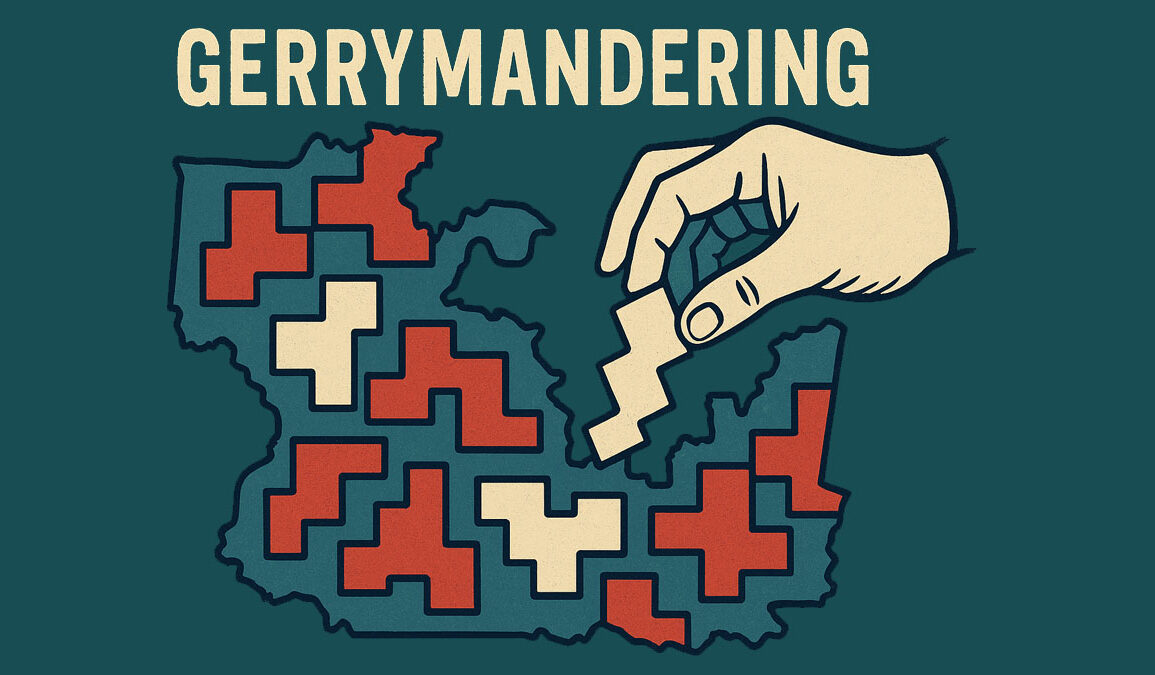What is gerrymandering?
Gerrymandering is the manipulation of electoral boundaries to give one political party an advantage over the other. Every ten years after the U.S. Census, states redraw congressional maps to reflect population changes. While the principle is to ensure equal representation, in practice lawmakers often twist the process to secure partisan gain.
The Supreme Court ruled in Rucho v. Common Cause (2019) that partisan gerrymandering is a political issue beyond the reach of federal courts. Chief Justice John Roberts wrote that “Federal judges have no license to reallocate political power between the two major political parties.” This means that while racially discriminatory maps are still illegal, partisan gerrymanders are permitted. The result is a system where parties openly redraw maps to cement their power, with critics arguing it allows “politicians to pick their voters rather than voters picking their elected officials.”
Texas sets off the fight
Texas has become the center of the new battle. At the urging of President Trump, Governor Greg Abbott and the Republican legislature approved a redistricting plan designed to flip as many as five House seats. Trump made clear why: losing the House would cripple his final two years in office. As he put it, Republicans must act “immediately” rather than wait for the 2030 Census.
The fight was bitter. Texas Democrats fled the state to deny Republicans the quorum needed to pass the maps. Abbott ordered them to return, even authorizing arrests. After a two-week standoff, Democrats came back, and the legislature voted 88-52 to approve the plan. The Senate swiftly endorsed it, and Abbott is expected to sign.
Democrats and civil rights groups insist the maps dilute minority power. Jon Taylor, a political science professor in San Antonio, warned, “Literally minutes after Abbott signs this bill and the redistricting plan goes into effect, there’ll be litigation.” Groups including the ACLU, NAACP, and MALDEF plan to sue. Republicans countered by saying the plan “creates four Hispanic districts out of five new ones.” The stakes are high: these maps could determine whether Trump’s party keeps the House majority in 2026.
California’s counterstrike
California responded with equal force. Governor Gavin Newsom declared it was time for Democrats to “play hardball.” He told reporters, “We tried to hold hands and talk about the way the world should be. We can’t just think differently, we have to act differently.”
The legislature voted to suspend California’s independent redistricting commission and put a new partisan map before voters in a November 4 special election, where it will appear as Proposition 50. The new maps are designed to flip five Republican seats and solidify three Democratic-leaning districts. Assemblymember Josh Lowenthal said, “If unaddressed, Texas’ actions – which occur without the vote of the populace – will disenfranchise California.”
Republicans in California strongly objected. Assemblymember James Gallagher argued, “There’s really only one way to stop – someone has to refrain from striking back, and show a better way.” Yet with Democrats holding three-quarters supermajorities, the plan sailed through. The fight will now move to the ballot box, where Californians must decide whether to set aside the independent system they approved in 2010, at least temporarily, to retaliate against Texas.
Missouri considers its move
Missouri has not yet redrawn its maps, but lawmakers are openly considering it. Republicans control the legislature and see an opportunity to lock in more GOP seats. While the state has fewer districts to manipulate than Texas or California, even small changes could insulate incumbents and limit Democratic competitiveness. Missouri faces fewer legal guardrails, so if the legislature acts, the new maps would likely survive. The debate there reflects a broader reality: redistricting is now viewed as a weapon, not just a bureaucratic duty.
Ohio’s mandatory redraw
Unlike other states, Ohio is legally required to redraw its congressional districts this year. Republicans dominate the legislature and governor’s office, giving them control over the process. In the past, courts have forced Ohio to revise maps that were heavily tilted toward Republicans, but the GOP still held a strong advantage. This year, experts expect Ohio lawmakers to push boundaries further, especially with Trump encouraging states to act. Democrats will likely sue again, but given the current judiciary, their chances are slim. Ohio is positioned to become a critical state in the arms race.
North Carolina’s long history
North Carolina has been at the heart of redistricting battles for decades. In 2019, the Supreme Court’s decision in Rucho v. Common Cause arose from North Carolina maps. Bob Phillips of Common Cause explained that the legislature had “punished voters because of their party affiliation, i.e., viewpoint discrimination.” The Court ruled otherwise, leaving partisan gerrymanders to state control.
Since then, North Carolina Republicans redrew maps in 2023 that eliminated several Democratic seats. The new Republican majority on the state Supreme Court upheld those maps, essentially giving lawmakers “free rein to draw maps that benefitted their party.” Interestingly, some longtime opponents of gerrymandering have softened their tone. Former Congressman Wiley Nickel admitted in an op-ed, “Blue states will need to match Republican gerrymandering, for the time being, in order to preserve our democracy.” Even Common Cause supported California’s retaliatory move. This shows how the ethical ground has shifted: those once against gerrymandering now embrace it as a defensive tool.
State-by-State Redistricting Actions
| State | Party in Control | Action Taken or Planned | Potential Impact |
|---|---|---|---|
| Texas | Republican | Legislature approved new maps adding five GOP seats at Trump’s urging. Democrats fled to block it but returned under threat of arrest. Civil rights groups plan lawsuits. | Could net Republicans five seats and maintain Trump’s House majority. Critics say it violates the Voting Rights Act. |
| California | Democrat | Suspended independent commission; legislature approved partisan maps to flip five GOP seats. Proposition 50 on Nov. ballot will decide if maps take effect. | Would cancel out Texas’ gain and make three more Democratic districts harder for Republicans to win. |
| Missouri | Republican | Considering mid-decade redistricting similar to Texas. No final vote yet, but GOP has legal ability to act. | Would secure Republican representation and insulate incumbents, though fewer districts at stake than Texas or California. |
| Ohio | Republican | Legally required to redraw maps this year. GOP expected to create more favorable districts. Democrats preparing lawsuits. | Likely to strengthen GOP control of Ohio’s delegation despite legal challenges. |
| North Carolina | Republican | Already redrew maps in 2023 after state Supreme Court said partisan gerrymandering cannot be blocked. Past plaintiffs like Common Cause now back California’s counter-gerrymander. | Three Democrats lost seats, Republicans gained firm control. Debate shows ethical shift as even opponents endorse retaliatory gerrymandering. |
The ethical dilemma
The spread of mid-decade redistricting shows how gerrymandering is both unavoidable and corrosive. Democrats argue Texas’ plan is a racial gerrymander. Republicans say California’s plan undermines the people’s will by suspending its independent commission. Both sides justify their actions as necessary to counter the other.
Chris Warshaw, a professor at Georgetown, warned, “It’s not clear where this ends. If Texas can do this this cycle and that sets off a chain reaction, why would we think there won’t be a whole another set of states that try to do this in 2027 and likewise in 2029?” The political chessboard, he noted, will reset again after the 2030 Census.
The ethical problem is that redistricting is, by definition, political. Independent commissions exist in some states, but legislatures can override or suspend them. Neither party seems willing to give up the advantage when power is on the line. As one observer put it bluntly, “Democracy can be messy, but it’s also been pretty stable and worked pretty well for us.”
Whether voters see gerrymandering as a safeguard against the other side or a direct threat to fair representation, the 2026 midterms will be shaped by these decisions. The arms race is here, and it may only intensify.








